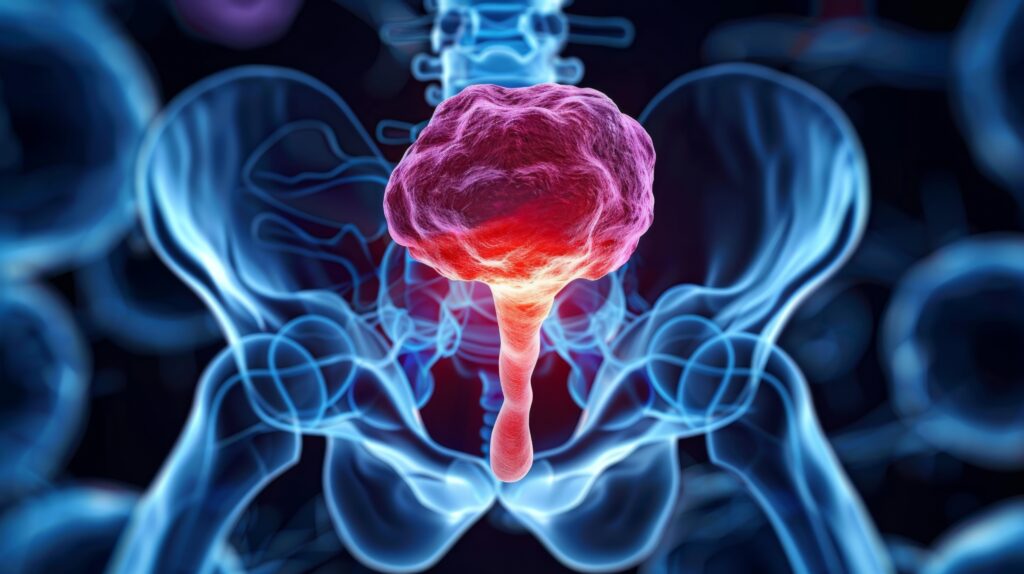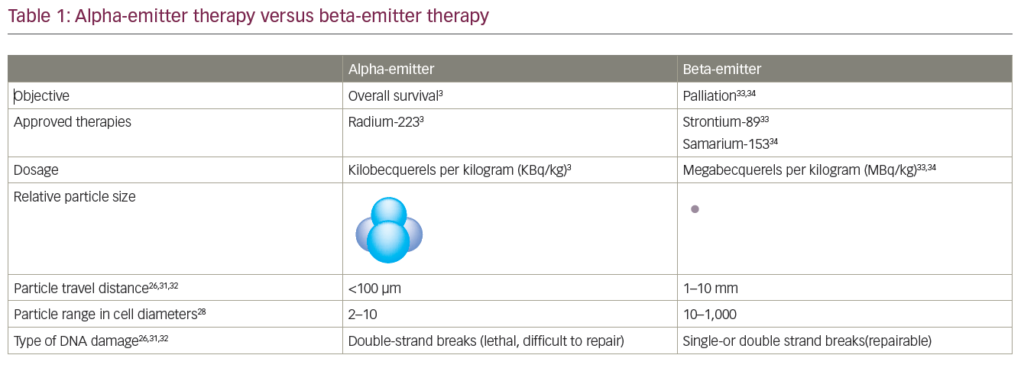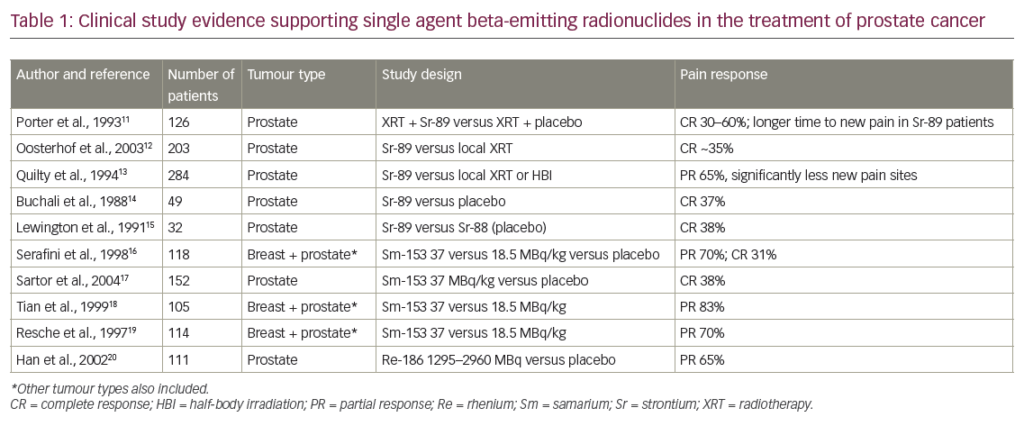Doxil as a Single Treatment Regimen for Hormone-refractory Prostate Cancer
A literature search identified six clinical trials in which liposomal doxorubicin was used as a single agent against prostate cancer. In the first pharmacokinetic study, published in 2000, 15 patients with hormonerefractory prostate cancer (HRPC) received Doxil either at 45mg/m2 every three weeks or 60mg/m2 every four weeks.3 A common side effect was stomatitis, which was higher among patients receiving the 60mg/m2 regimen, whereas hand–foot syndrome was more frequent among patients receiving the 45mg/m2 regimen. The toxicity indicated that neither dose regimen was tolerable, but a modest activity of Doxil against HRPC justified future studies. The modest effect of Doxil as a single agent against HRPC was confirmed in subsequent studies (see Table 1). In one small study no clinical response was observed, but the authors suggested that a phase II trial with 20mg/m2 liposomal doxorubicin was warranted.4 However, even this dose may have been insufficient to elicit a biochemical response, since the only studies that report a decrease in prostate-specific antigen (PSA) (>50%) administered Doxil at concentrations of 40mg/m2 or greater once every four weeks.3,5–8 This is illustrated in the largest phase II study, which was conducted in Germany.6 Since an optimal schedule had not been established, Doxil was administered at either 25mg/m2 every two weeks for 12 cycles or 50mg/m2 every four weeks for six cycles. Interestingly, while all patients received Doxil at 12.5mg/m2/week, only the group treated with the less frequent but higher dose had a biochemical response (see Table 1). Studies also found that PSA is not always a reliable measure of treatment response. For example, in some patients PSA increased after initiation of Doxil treatment, but subsequently decreased to below levels at treatment initiation.5,6 The initial increase in PSA can easily be misinterpreted as treatment failure. On the other hand, a decrease in PSA may occur while the disease is progressing, and is possibly indicative of a change toward a low-PSA-producing tumor.7
PSA = reduction in PSA levels by at least 50%.
SD = stable disease.
Hb = hemoglobin.
SR = subjective response.
HFS = Hand–foot syndrome.
* Did not use pegylated liposomes. Coating of liposomes with polyethylene glycol (PEG) facilitates immune system evasion.
Other parameters evaluated in some of the studies included survival, quality of life, and pain relief. In one study the average survival of all patients was eight months, whereas the responders survived 12 months on average (in a range of 8–20 months),3 while in another study survival among the responders was 13 months (in a range of 9–15 months).7 Two studies utilized a questionnaire (EORTC QLQ-C30) to evaluate the effect of Doxil treatment on quality of life but, unfortunately, no improvements could be reported.6,7 However, Doxil did relieve pain in about half (52%) of the patients receiving 50mg/m2 every four weeks. Despite the superior palliative effect among these patients, the authors concluded that this treatment regimen is unlikely to become routine due to the frequency of associated toxicities.6 Combination Therapy with Doxil
Because chemotherapy was thought to be ineffective against prostate cancer, few studies have investigated the role of chemotherapy in patients without distant metastases.9 However, since adjuvant chemotherapy has improved the cure rate of node-positive breast and colon carcinoma, one group studied the effect of adjuvant chemohormonal therapy in prostate
cancer patients with stage III positive seminal vesicles or lymph nodes.10 Treatment consisted of six courses of chemotherapy (vinblastine, doxorubicin, and mitomycin) concurrent with radiation and hormone ablation. In general, treatments were well tolerated. Seventy-three percent of patients experienced relapse-free survival (defined as <0.1ng/ml PSA) 10 years after treatment, and only 20% (five out of 25) died of prostate carcinoma. In contrast, of the 10 patients who qualified for the study but refused to participate, only one (10%) remained relapsefree at 10 years and five (50%) died of prostate carcinoma. These results are encouraging, but it is not clear whether chemotherapy—specifically doxorubicin—contributed to the outcome or whether hormone ablation without additional chemotherapy would have yielded similar results. Two additional studies specifically examined the benefit of Doxil in combination with other therapies. In a feasibility study, neoadjuvant Doxil (two cycles of 50mg/m2 every four weeks) prior to hormonal and radiation therapy did not appear to have any therapeutic benefit and was negatively impacted by significant side effects.11 Six of seven patients remained alive at the time of publication (3–4 years after treatment) with four having a stable PSA without hormonal therapy. In a larger study, which included 48 patients with solid tumors, Doxil (6–14mg/m2/wk) was combined with docetaxel (20–35mg/m2/wk).12 Of the 27 prostate cancer patients enrolled in this study, 24 had a PSA response and three of 19 patients with HRPC and measurable soft-tissue disease had a partial response. The weekly treatment regimen was well tolerated with only a few grade 3 toxicities observed. Therefore, this approach warrants further study.
Ongoing Clinical Trials
Currently, three clinical trials are recruiting patients for combination therapy with Doxil (Clinical trials.gov identifiers NCT00307294, NCT00398879, NCT00176293). In an exploratory phase II trial, perifosine or a placebo will be combined with one of six chemotherapies (including Doxil) based on disease type. Perifosine inhibits phosphorylation of Akt— an enzyme associated with cell survival—which is often constitutively active in prostate cancer due to protein tyrosine phosphatase or phosphatase and tensin homolog (PTEN) deletions.13 In culture, perifosine resulted in growth inhibition of the androgen-independent prostate cancer cell line PC3, which is PTEN-negative.14,15 However, in a phase II trial with perifosine, no radiographic response or decrease in PSA levels was observed.16 It is possible that the effectiveness of perifosine is limited to patients whose tumors have constitutive activation of Akt. Interestingly, inhibition of Akt in PC3 cells results in sensitization to doxorubicin,17 which suggests that the combination of perifosine (to inhibit Akt) and Doxil may be an effective treatment strategy for prostate cancer patients with PTEN deletions. PTEN deletions have been detected in 68% of prostate cancers (24 out of 35).13 Another trial is evaluating the effect of dexamethasone pre-treatment (12mg twice a day on days 1–5 of the cycle) followed by 50mg/m2 Doxil on day five of a four-week cycle. Of note here is a case report in which an unexpected response of HRPC was observed following treatment with an antileukemic chemotherapy regimen that included doxorubicin and dexamethasone.18 The patient had progressive prostate cancer when diagnosed with leukemia. PSA levels decreased in response to chemotherapy and, although the patient died of leukemia-related sepsis, autopsy revealed minimal evidence of prostate cancer confined to the gland.
Lastly, a phase II trial will be conducted using a combination of Doxil and thalidomide. The exact mechanism of action of thalidomide remains unclear, but it has been postulated to inhibit angiogenesis and has also been shown to modulate cytokine levels. Thalidomide used as a single agent in a phase II trial resulted in a greater than 50% decrease in PSA levels in 15% of the patients.19 Combination of thalidomide and docetaxel resulted in a PSA decrease in 53% of patients with improved overall and progression-free survival of prostate cancer patients.20 The combination of Doxil with perifosine, dexamethasone, or thalidomide may yield some interesting new insights into novel treatment regimens for prostate cancer.
Promising Insights from Laboratory Research
The common goal for the treatment of cancer is to eliminate the malignant cells while sparing normal cells. This can be accomplished by selective toxicity toward tumor cells, targeted delivery, or exploitation of the abnormal tumor vasculature. Although significant strides have been made toward these goals, the shortfalls have motivated researchers to improve current strategies. The discovery of tumor necrosis factor-alpha-related apoptosisinducing ligand (TRAIL) in the 1990s generated significant excitement, since this death ligand selectively killed tumor but not normal cells. Unfortunately, several groups—including ours—have shown that prostate cancer cells are relatively resistant to recombinant TRAIL in culture.21,22 The resistant phenotype can be reversed by doxorubicin pre-treatment, which correlates with downregulation of the anti-apoptotic protein cellular FLICEinhibitor proteins (cFLIPs).23 Most recently we found that free radicals generated by interaction of doxorubicin with iron are responsible for decreased expression of cFLIPs as well as other anti-apoptotic proteins.24 Downregulation of these proteins—which functionally oppose activation of caspases—leads to a cellular phenotype that is much more susceptible to apoptotic stimuli such as TRAIL. Whether cancer cells can be selectively sensitized to TRAIL by doxorubicin is controversial. Selectivity for cancer-cell killing is not achieved in cultured normal human cells, but combination of TRAIL and doxorubicin has no adverse effects in mice.21,25,26 It is unclear whether a species difference or cell-culture artifacts account for this discrepancy. Recently, it has been shown that the bacterial protein liposomerase enhances the release of liposomally encapsulated drugs.27 This approach aimed at incorporating selective toxicity, targeted delivery, and the abnormal tumor vasculature into one therapeutic strategy. Mice were first injected with spores of Clostridium novyi-NT, an anaerobic bacterium that can grow only under hypoxic conditions such as the tumor environment. The bacteria’s hemolytic properties were predicted to enhance the release of liposomally encapsulated drugs such as Doxil. Doxil was administered following germination of the bacterial spores in the experimental tumors. Combination treatment with spores and Doxil was superior to any single treatment, resulting in complete regression of tumors in all mice. At 90 days, 65% of mice receiving spores and Doxil were alive while all mice receiving spores and aqueous doxorubicin died within two weeks. The combination of Doxil with heat-inactivated spores was not of therapeutic value, indicating that proliferation of the bacteria to release doxorubicin from the liposomes within the tumor was crucial for efficacy of this treatment strategy. The bacterial treatment resulted in a selective six-fold higher concentration of doxorubicin in tumors. In the past, bacteriolytic therapy was effective only against large tumors with significant necrotic lesions that were oxygen-deprived. The combination with liposomally encapsulated drugs, however, was also effective against smaller tumors, which would be of significance for prostate cancer metastases.
Conclusion
The benefit of chemotherapy for prostate cancer has been questioned since, so far, single or combination therapies have been largely ineffective. Lipid encapsulation of doxorubicin has improved the toxicity profile of the drug, but effectiveness is likely to be achieved only by combination with other strategies. Ideally, these strategies should be based on our continually evolving understanding of prostate cancer, signaling pathways, and cellular mechanisms that induce cell death. Stratification of patients enrolled into clinical trials based on molecular defects may also improve outcomes.















